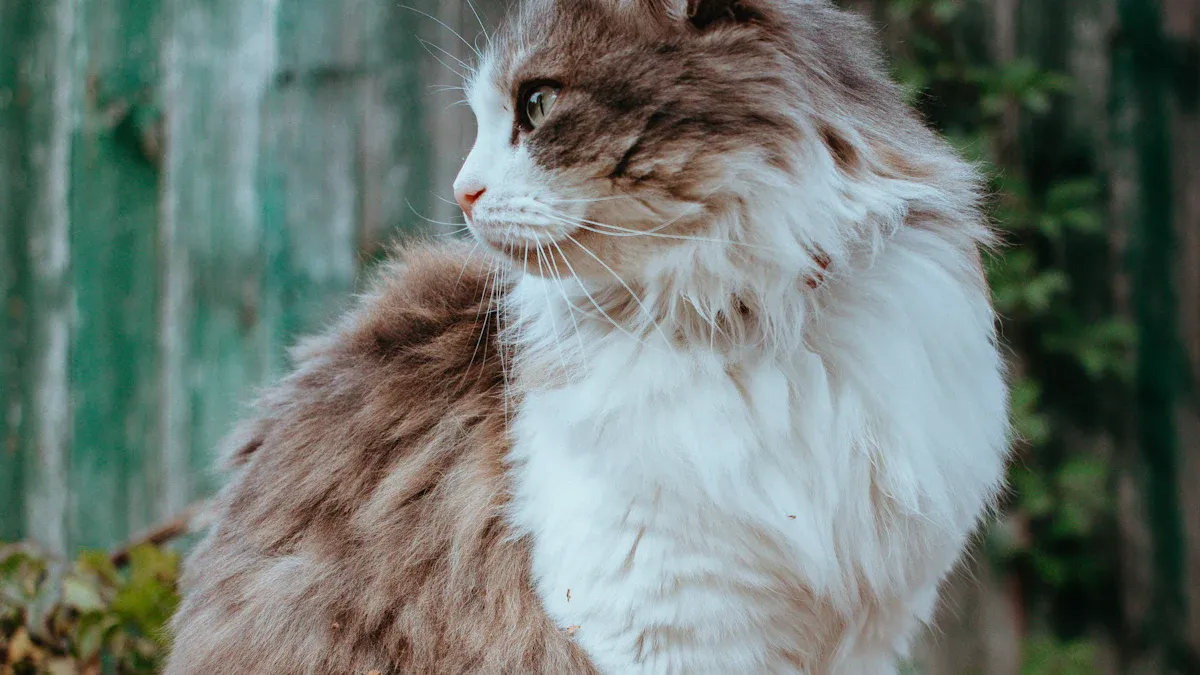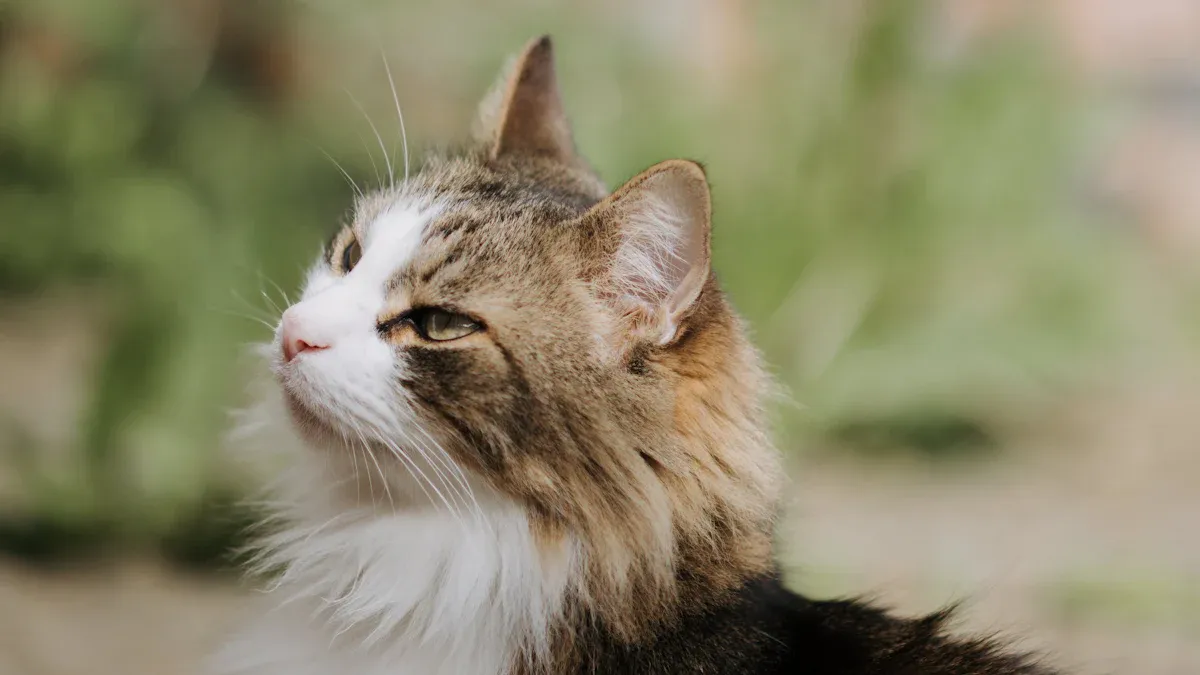
Are you searching for a cat that’s beautiful and flexible? The Norwegian Forest Cat could be the one for you. These cats are famous for their stunning looks and kind personality. They can fit well into many different lifestyles. Male cats usually weigh 12 to 20 pounds. Female cats weigh between 10 and 18 pounds. This makes them strong but also elegant. They adapt well, scoring 8 out of 10 for flexibility. They can live up to 16 years, which is impressive. Whether you live in a small apartment or a big house, this cat can add joy and charm to your life.
Key Takeaways
Norwegian Forest Cats can live in small apartments or big houses.
They need food with lots of protein, at least 50% from animals.
Brush their thick fur two times a week to avoid knots.
Play with them every day for 15-20 minutes using fun toys.
They can live up to 16 years, so plan for their care and vet visits.
Unique Traits of the Norwegian Forest Cat
Physical Characteristics
Size and Build
Norwegian Forest Cats are large and strong. Male cats weigh 10 to 20 pounds. Female cats weigh 8 to 18 pounds. They have long, muscular bodies and strong legs. Their back legs are longer than their front legs. This helps them climb very well. They also have a wide chest and a thick neck. These features make them look powerful and graceful.
Characteristic | Measurement/Description |
|---|---|
Weight (Females) | 8–18 lb (3.6–8 kg) |
Weight (Males) | 10–20 lb (4.5–9 kg) |
Body Type | Long body, strong legs, and a fluffy tail |
Growth Duration | Takes up to five years to fully grow |
Coat and Colors
The coat of this cat is thick and soft. It has a waterproof top layer and a warm undercoat. This keeps them cozy in cold weather. Around their neck, they have extra fluffy fur. Their coat comes in many colors like white, black, red, and tabby. They also have a long, bushy tail and furry ears. These features make them look royal and elegant.
Personality and Behavior
Affectionate Yet Independent
These cats are loving but not needy. They like being near people but don’t need constant attention. They enjoy watching what’s happening around them. Their calm and friendly nature makes them great for families or single owners.
Playful and Intelligent
Norwegian Forest Cats are curious and love to play. They enjoy climbing, exploring, and playing games. They are smart and can solve puzzles or learn tricks. Giving them toys and fun activities keeps them happy and busy.
Practical Care for a Norwegian Forest Cat
Diet and Nutrition
High-Quality Food Choices
Your Norwegian Forest Cat needs food with lots of animal protein. This keeps their muscles strong and gives them energy. Choose cat food with at least 50% animal protein, like chicken or salmon. Fatty acids, such as omega-3 and omega-6, help their thick coat and brain. Taurine is also important for their heart and eyes.
Nutrient Group | Ideal Percentage | Importance | Best Sources |
|---|---|---|---|
Animal Protein | At least 50% | Gives energy, amino acids, vitamins, and minerals. | Chicken, Turkey, Duck, Liver, Tuna, Mackerel, Salmon, Prawns, Sardines |
Animal Fat | Up to 20% | Helps with hydration and cell health. | Ham, Pork, Bacon |
Vitamins and Minerals | N/A | Needed for body functions and overall health. | Liver, Fish, Wheat Germ Oil |
Feeding Schedule and Portion Control
Feed your cat at the same times every day. Adult cats eat two meals daily, while kittens need three smaller meals. Watch portions to avoid weight gain. Use the food package guide to decide how much to feed. Adjust based on your cat’s activity and size.
Grooming Requirements
Managing Their Thick Coat
The Norwegian Forest Cat has a thick coat that needs care. Brush it twice a week to stop tangles. During shedding seasons, brush daily to remove loose fur. Use a slicker brush or metal comb made for long-haired cats.
Tip: Grooming often keeps their coat nice and helps you bond with your cat.
Seasonal Shedding Tips
These cats shed more in spring and fall. Brush them more often during these times to reduce fur around your home. A wire bristle brush removes loose hair well. A grooming glove is gentler for sensitive cats.
Health Considerations
Common Health Issues
Like other cats, Norwegian Forest Cats can have health problems. Hypertrophic Cardiomyopathy (HCM) affects their heart muscle. Hip dysplasia can make moving painful. Glycogen Storage Disease Type IV (GSD IV) is a rare genetic issue. Regular vet visits can catch these problems early.
Health Issue | Description |
|---|---|
Hypertrophic Cardiomyopathy (HCM) | A heart problem where the heart muscle thickens, causing failure. |
Hip Dysplasia | A joint issue that makes moving hard and may need surgery. |
Glycogen Storage Disease Type IV (GSD IV) | A genetic disease that can cause serious nerve problems in kittens. |
Importance of Regular Vet Visits
Taking your cat to the vet often is very important. Vets can do heart tests and other checks for issues like HCM. Finding problems early helps treat them better, keeping your cat healthy and happy.
Living Needs of a Norwegian Forest Cat

Indoor vs. Outdoor Preferences
Safe Outdoor Exploration
Norwegian Forest Cats love to explore and are very curious. To let them enjoy the outdoors safely, build a catio or secure enclosure. This allows them to climb, watch, and play without danger. Outdoor risks like cars or wild animals can harm them. Keeping them safe is very important. They do well in cold weather but also need a warm indoor spot to rest after exploring.
Adapting to Apartment Living
Although these cats come from outdoor roots, they live well indoors. They score 9 out of 10 for indoor adaptability. In apartments, give them vertical spaces like shelves or cat trees. These let them climb and look around, keeping them entertained. Fun toys and daily playtime will keep them active and happy.
Compatibility with Families and Pets
Interaction with Children
Norwegian Forest Cats are kind and good with kids. They like spending time with people and are patient with children. Their playful side makes them great for family games. Teach kids to handle them gently for a good experience for both.
Getting Along with Other Pets
These cats are friendly and adjust well to other pets, even dogs. Their calm and loving nature suits homes with multiple animals. Introduce them to new pets slowly so they can get used to each other. Over time, they may become close friends with other pets.
Space and Activity Requirements
Providing Enrichment and Play
These cats need exercise every day to stay healthy. Play with them for 15 to 20 minutes twice daily. Activities like climbing, chasing toys, or solving puzzles keep them busy. They enjoy “hunting,” so toys that act like prey are great. Playtime helps prevent weight gain and satisfies their instincts.
Creating a Comfortable Home Environment
Make your home welcoming by adding spaces for their needs. Use cat trees or shelves for climbing and exploring. Scratching posts help their claws and protect furniture. A cozy spot by a window can be their favorite place to relax. These small changes make your home perfect for your cat.
Key Considerations for First-Time Owners
Costs of Owning a Norwegian Forest Cat
Adoption or Purchase Costs
Getting a Norwegian Forest Cat costs money at the start. Adopting from a shelter is cheaper, usually about $100. Buying from a breeder is more expensive, costing $800 to $2,000. The price depends on the breeder and the cat’s family history.
Cost Type | Price Range |
|---|---|
Purchase from Breeder | |
Adoption from Shelter | Around $100 |
Ongoing Expenses (Food, Vet, Grooming)
Owning this fluffy cat means regular spending. Good food keeps them healthy and their fur shiny. Monthly vet visits, grooming tools, and sometimes pet insurance add to the cost. Planning ahead helps you care for your cat properly.
Cost Type | Estimated Amount |
|---|---|
Routine Vet Visits | Monthly (varies) |
Annual Health Insurance | Varies |
High-Quality Food | Monthly (varies) |
Neutering/Spaying | One-time cost (varies) |
Microchipping | One-time cost (varies) |
Time Commitment
Daily Interaction and Playtime
These cats are smart and love to play. Spend 15-20 minutes twice a day playing with them. Use toys that move like prey to keep them interested. Give them places to climb, like shelves or cat trees, to explore.
Play with your cat two times daily for 15-20 minutes.
Use moving toys to make playtime exciting.
Add climbing spots to keep them curious and happy.
Grooming and Maintenance Time
Their long fur needs brushing often. Brush them a few times weekly to stop tangles. During shedding seasons, brush every day to control loose fur. Grooming keeps their coat neat and builds a stronger bond with them.
Long-Term Care
Lifespan and Aging Considerations
These cats can live up to 16 years, so they are a big commitment. Older cats may need special food or more vet visits. Being ready for these changes helps them stay healthy as they age.
Planning for Their Needs Over Time
Think about how your life might change in the future. Will you have time for grooming and play? Can you handle health issues as they grow older? Planning ahead ensures your cat gets the best care.
Tip: Regular vet visits and a steady routine help your cat live a happy life.
Norwegian Forest Cats are great pets for anyone wanting a loyal friend. They are loving and friendly, making them ideal for families or singles. These cats can live happily in small apartments or large houses.
They usually live 14 to 16 years, sometimes even longer. Their grooming is easier than many other long-haired cats. If you can meet their care needs, they will bring lots of happiness to your life.
Tip: Regular grooming and playtime keep your Norwegian Forest Cat healthy and cheerful!
FAQ
Are Norwegian Forest Cats good pets for families?
Yes, they are great! These cats are kind and patient. They are fun for kids and stay calm in busy homes. Teach children to be gentle with them.
Do Norwegian Forest Cats get along with dogs?
Yes, they do! These cats are friendly and easygoing. Introduce them to dogs slowly and carefully. Watch their first meetings to ensure they get along.
How much grooming does a Norwegian Forest Cat need?
Their thick fur needs brushing two times a week. Brush daily during shedding seasons to remove loose hair. Grooming keeps their coat nice and helps you bond with them.
Can Norwegian Forest Cats live in apartments?
Yes, they can! These cats adjust well to living indoors. Give them shelves or cat trees to climb. Play with them daily to keep them happy and active.
Are Norwegian Forest Cats hypoallergenic?
No, they are not. Their fur can cause allergies in some people. Spend time with one first to check for reactions. Grooming and cleaning often can lower allergens.
